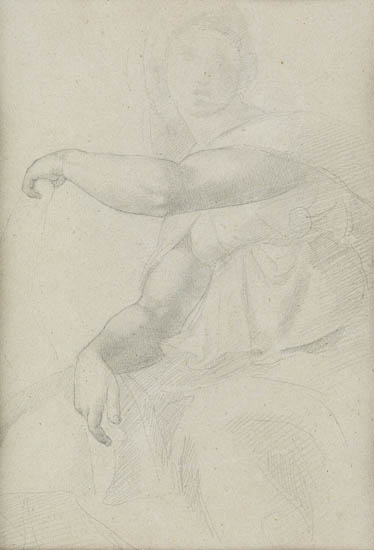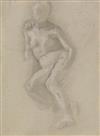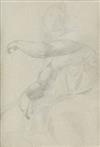Sale 2322 - Lot 63
Unsold
Estimate: $ 15,000 - $ 20,000
EDGAR DEGAS
Etude d'après La Sibylle de Delphe (recto); and Académie de Femme (verso).
Pencil with white gouache heightening (verso), double-sided, circa 1855-56. 305x247 mm; 12x9 3/4 inches. Ex-collection Lee V. Eastman, New York; sold Christie's, New York, March, 1 2006, lot 31.
Professor Theodore Reff, New York, has stated that in his opinion this drawing is by Edgar Degas.
While Degas (1834-1917) is often associated with Impressionism, his now famous renditions of modern scenes of Parisian demimonde characters, ballet dancers and bathers were heavily influenced by his early technical training which focused on sketching from Italian Renaissance masters. Born to a wealthy banking family, Degas was first educated in one of the most rigorous and prestigious schools in Paris, the Lycée Louis-le-Grand, where he learned the classics. His father recognized Degas' ability to draw at an early age and prompted him to perfect his technique, taking him to the great museums of Paris to copy the Renaissance masters. In the late 1850s, Degas made several sojourns to Italy to sketch. In Italy he became deeply engrossed in rendering the static human forms of early Renaissance frescos and, while he did not continue to produce artwork in an academic style, this significant, initial training is apparent in his approach to the figure.
This exquisitely rendered, double-sided work was clearly drawn during one of his visits to Rome--one side depicts a study of the Delphic Sybil from Michelangelo's famed frescos in the Sistine Chapel. In his study, Degas focused his attention on the contours of the elegant and powerful arms of the Sybil, leaving her face and drapery subtly addressed by comparison. The other side of the sheet represents an academic drawing of a woman, perhaps rendered from life, and similarly focuses on the curved outlines of the torso. As Degas' studio practice progressed, his focus on strong contours outlining the body, all the while obscuring the face, became part of his individual style and compositions. Degas would continue to be influenced by various artistic traditions throughout his career, ranging from 16th-century Italian Mannerist works to traditional Japanese Ukioy-e woodcuts.
Etude d'après La Sibylle de Delphe (recto); and Académie de Femme (verso).
Pencil with white gouache heightening (verso), double-sided, circa 1855-56. 305x247 mm; 12x9 3/4 inches. Ex-collection Lee V. Eastman, New York; sold Christie's, New York, March, 1 2006, lot 31.
Professor Theodore Reff, New York, has stated that in his opinion this drawing is by Edgar Degas.
While Degas (1834-1917) is often associated with Impressionism, his now famous renditions of modern scenes of Parisian demimonde characters, ballet dancers and bathers were heavily influenced by his early technical training which focused on sketching from Italian Renaissance masters. Born to a wealthy banking family, Degas was first educated in one of the most rigorous and prestigious schools in Paris, the Lycée Louis-le-Grand, where he learned the classics. His father recognized Degas' ability to draw at an early age and prompted him to perfect his technique, taking him to the great museums of Paris to copy the Renaissance masters. In the late 1850s, Degas made several sojourns to Italy to sketch. In Italy he became deeply engrossed in rendering the static human forms of early Renaissance frescos and, while he did not continue to produce artwork in an academic style, this significant, initial training is apparent in his approach to the figure.
This exquisitely rendered, double-sided work was clearly drawn during one of his visits to Rome--one side depicts a study of the Delphic Sybil from Michelangelo's famed frescos in the Sistine Chapel. In his study, Degas focused his attention on the contours of the elegant and powerful arms of the Sybil, leaving her face and drapery subtly addressed by comparison. The other side of the sheet represents an academic drawing of a woman, perhaps rendered from life, and similarly focuses on the curved outlines of the torso. As Degas' studio practice progressed, his focus on strong contours outlining the body, all the while obscuring the face, became part of his individual style and compositions. Degas would continue to be influenced by various artistic traditions throughout his career, ranging from 16th-century Italian Mannerist works to traditional Japanese Ukioy-e woodcuts.
Exhibition Hours
Exhibition Hours
Aliquam vulputate ornare congue. Vestibulum maximus, libero in placerat faucibus, risus nisl molestie massa, ut maximus metus lectus vel lorem.






